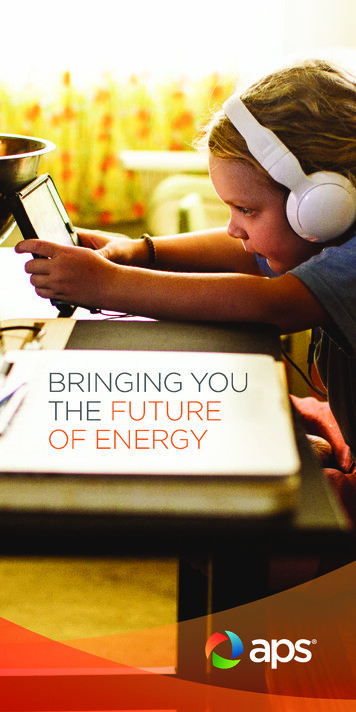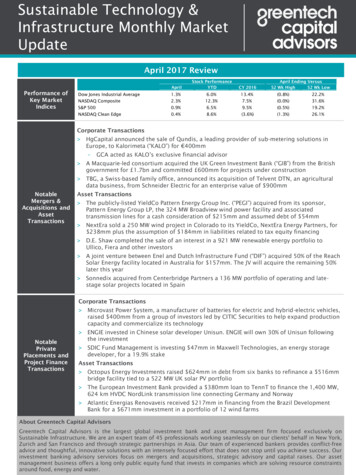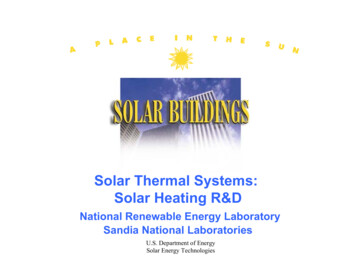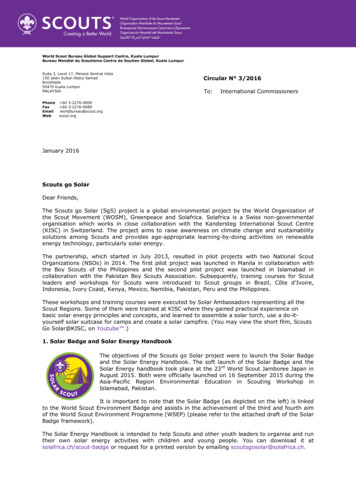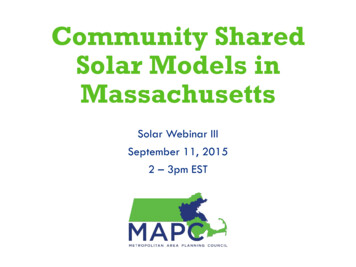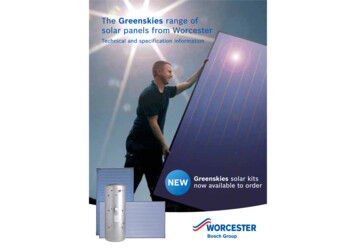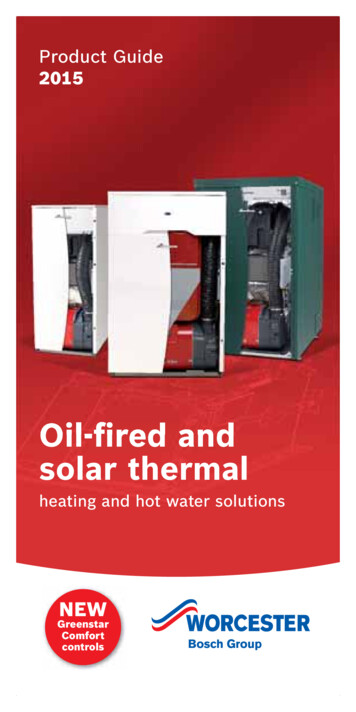![Solar Code Development V2.5 [Read-Only]](/img/63/solar-20code-20development-20vfinal.jpg)
Transcription
Solar Code DevelopmentAn Introduction to the Practice and the Process
Agenda Model Code Development Solar Code Requirements SEIA Engagement
SpeakersEvelyn M. ButlerSEIADirector,Codes &Standards8/2/2016Joseph Cain, P.E.Chair, SEIA Codes& StandardsWorking GroupJason Fisher,SolarCity,SEIA rep forNFPA 70 CMP4John Taecker, P.E.UL LLCSr. RegulatoryEngineer 2016 Solar Energy Industries Association 3Thomas KiggenSEIADirector,Membership
Model Code DevelopmentJohn Taecker, UL LLC
The U.S. Safety SystemInstallationCodesProduct Standards andCertificationInspection andEnforcementSafe Products and SafeInstallations5
Purpose of Installation Codes and StandardsBasis for adoption by jurisdictionsReasonable and practical safeguarding of people andpropertyMitigate hazards Fire Electric shock Personal injurySustainability and environmentalimpact6
Code development driversNew technologyField incidentsImprovement Research Enforcement issues Interpretations7
How model codes address new technologyCode proposalsAlternate materials and methodsTemporary Interim Amendments (TIAs) Technical merit Emergency nature8
U.S. Model Installation Codes and Standards DevelopersASHRAE – American Society of Heating, Refrigerating and Air-Conditioning EngineersIAPMO – International Association of Plumbing and Mechanical OfficialsICC – International Code CouncilNFPA – National Fire Protection Association9
ASHRAE (www.ashrae.org)ASHRAE 90.1 - Energy Standard for Buildings Except Low-Rise Residential BuildingsASHRAE 189.1 - Standard for the Design of High-Performance Green Buildings10
IAPMO (www.iapmo.org)Uniform Plumbing CodeUniform Mechanical CodeUniform Solar Energy and Hydronics Code11
ICC (www.iccsafe.org)International Building CodeInternational Existing Building CodeInternational Residential CodeInternational Fire CodeInternational Plumbing CodeInternational Mechanical CodeInternational Energy Conservation CodeInternational Green Construction Code12
NFPA (www.nfpa.org)National Electrical Code (NFPA 70)National Fire Code (NFPA 1)Building Construction and Safety Code (NFPA 5000)13
ANSI-Consensus Process (ASHRAE / IAPMO / NFPA)Submit ProposalTechnical Committee Meeting Report on Proposals (ROP) or First Draft ReportSubmit Public CommentTechnical Committee Meeting Report on Comments (ROC) or Second Draft ReportTechnical Committee Reporting SessionStandards CouncilFinal vote Any member of the association present at the TCRS14
Governmental-Consensus Process (ICC)Submit Proposal Monograph publishedCode Action Hearing (CAH) Report on CAHSubmit Public Comment Public Comment Hearing Agenda publishedPublic Comment Hearing (PCH) PCH Results publishedFinal vote Governmental members of ICC15
StakeholdersManufacturersDesignersInstallersThird Party Certification and Testing OrganizationsAuthorities Having Jurisdiction (AHJs)Fire ServiceAcademiaInsuranceBuilding Owners and Facility Managers16
How to be involvedMake proposalsShow up to testify at code action and public comment hearingsParticipate in key chapter meetings prior to code hearingsBooth at AHJ organization conference exposUSEHC proposals are due July 1, 2016IBC-Structural and IFC public comments are due July 22, 201617
Code Resources and Supporting DocumentsASHRAE - HandbooksIAPMO - Illustrated Training ManualsICC - Code Commentaries and International Solar Energy ProvisionsNFPA - Handbooks18
Adoption of codes and regulationsAmended by federal, state, and local governmentRegulations establish requirements for standardsRegulations establish requirements for third party certification OSHA – Nationally recognized testing laboratories (NRTLs) – 29 CFR 1910 States Cities and Counties19
Solar Code RequirementsJoseph Cain, P.E.Chair, SEIA Codes & Standards Working Group
International Fire Code (IFC) and NFPA 1 Exemption/modification forsolar access roads (IFC 503) Rooftop access pathways andfire setbacks (IFC 605.11) Residential– Access pathways to ridge– Setbacks at ridge Nonresidential (low-slope)– Perimeter & interior pathways– Smoke & heat vents; hatches– SkylightsAugust 2, 2016 2016 Solar Energy Industries Association 21
International Building Code (IBC) Rooftop-mounted PV Systems– Fire Classification (1505.9, 1510.7)– Wind provisions (1510.7)– Live load (1607.12.5) Ballasted, unattached PVsystems on low-slope roofs– Seismic provisions (1613.6) BIPV solar shingles– Fire Classification (1505.8)– Installation (1507.17)– Wind provisions (1507.17.8)August 2, 2016 2016 Solar Energy Industries Association 22
International Residential Code (IRC) Rooftop-mounted PV systems– Fire classification (R902.4, R907.3)– Wind provisions (R907.2)– Live load (R324.4.1) BIPV solar shingles (R905.16)– Fire classification (R902.3)– Wind resistance (R905.16.7) Solar thermal energy systems(Chapter 23) Solar Ready Roofs (Appendix U)August 2, 2016 2016 Solar Energy Industries Association 23
International Residential Code (IRC) Important: Rooftop setbacks andaccess pathways printed in errorin 2015 IRC 1st printing (R324.7) Group R-3 occupancies (singlefamily and duplex) covered in2015 IFC Intent was to cover IRC one- andtwo-family dwellings within IRC Disapproved at Final Hearing R324.7 does not really exist SEIA working on fix for 2018 IRCAugust 2, 2016 2016 Solar Energy Industries Association 24
International Existing Building Code (IEBC) 2015 International ExistingBuilding Code (IEBC) is stillsilent on solar SEIA proposal for 2018 IEBCwas disapproved at ICCCommittee Hearings There might be attempts tobring it back with publiccommentsAugust 2, 2016 2016 Solar Energy Industries Association 25
Int’l Energy Conservation Code (IECC) Definition “on-site renewableenergy” (C202) Residential Energy RatingIndex (ERI) method (R406) Residential Solar ReadyRoofs (Appendix RB) ASHRAE 90.1 is anotherenergy standard forbuildings (excluding low-riseresidential buildings)August 2, 2016 2016 Solar Energy Industries Association 26
Int’l Green Construction Code (IgCC) 2015 InternationalGreen ConstructionCode (IgCC) is still lighton solar provisions 2015 IgCC is not widelyadopted For 2018 edition, IgCCis being combined withASHRAE 189.1, anddeveloped under theASHRAE processAugust 2, 2016 2016 Solar Energy Industries Association 27
Int’l Plumbing & Mechanical Codes (IPC,IMC) Solar Heating &Cooling (SHC) aka“Solar thermal” ST panels Storage tanks Heat exchangers Roof anchors for fallprotectionAugust 2, 2016 2016 Solar Energy Industries Association 28
Uniform Plumbing & Mech. Codes (UPC,UMC) Solar Heating &Cooling (SHC) aka“Solar thermal” ST panels Storage tanks Heat exchangers Roof anchors for fallprotectionAugust 2, 2016 2016 Solar Energy Industries Association 29
International Solar Energy Provisions (ISEP) Assembled and published by ICC ISEP is not a model code Solar provisions from several“I-codes” integrated into one book Select solar electrical provisionsincluded under agreement withNFPA ICC commentary added Serves as a quick reference forimplementation and enforcementAugust 2, 2016 2016 Solar Energy Industries Association 30
Uniform Solar Energy & Hydronics (USEHC) 2012 USEC was for solar thermalcomponents & systems only 2015 edition expanded for PV &hydronics, and renamed USEHC. Select solar-specific PV electricalcode requirements includedunder agreement with NFPA– Electrical provisions not all-inclusive– Applicable provisions are also foundin NEC Chapters 1 through 4– Need to use NEC for other req’sAugust 2, 2016 2016 Solar Energy Industries Association 31
NFPA 70: National Electrical CodeJason Fisher, SolarCitySEIA Representative to NFPA 70 Code Making Panel 4With Ward Bower, Ward Bower Innovations
National Electrical Code (NEC) NFPA-70 Covers the majority of electricalinstallations Not covered – autos, boats,planes, trains, mines, utilityowned generation and T&D Covers some utility-ownedproperty (i.e. offices) Covers privately-ownedgenerationAugust 2, 2016 2016 Solar Energy Industries Association 33
NEC Revision Process Authored by volunteers frombroad stakeholder groups 19 Code-Making Panels (CMP) Correlating Committee– Manufacturers, Users, Installer/Maintainers, Labor, Research/Testing, Enforcement, Insurance,Consumers, Special Experts SEIA has seat on CMP-4 (JasonFisher and Ward Bower) coveringPV, Wind, Interactive Systemsand MicrogridsAugust 2, 2016 2016 Solar Energy Industries Association 34
NEC Content Introduction 9 Chapters Annexes (not enforceable) Chapters include:– Articles– Parts– Sections Chapters 1-4 apply to allelectrical installations (unlessmodified by chapters 5-7) Chapters 5-7 are specialconditions (PV 690 and 705)August 2, 2016 2016 Solar Energy Industries Association 35
NEC VersionsSignificant Impacts on PV: 2008 Expanded listed PV equiprequirements 2011 New PV dc Arc FaultProtection 2014 Expanded Arc FaultProtection and Ground FaultProtection. New Rapid Shutdown By Mid 2017 Most of the U.S. isexpected be on 2014 versionAugust 2, 2016 2016 Solar Energy Industries Association 36
NEC Current Revision 2017 revision based on 4,000Public Inputs to be published late2016 includes: Major rewrites to Article 690 (PV) Expanded Rapid Shutdown New Articles:––––691 Large Scale PV706 Energy Storage (480 remains)710 Stand Alone Systems712 DC Microgrids SEIA was heavily involvedAugust 2, 2016 2016 Solar Energy Industries Association 37
NEC Next Version2020August 2, 20162020 Revision Cycle Approx. Dates(see www.nfpa.org) Public Input before July 2017 First Draft Meeting Dec 2017 Public Comments on First DraftMay 2018 Second Draft Meeting Nov 2018 NITMAMs before Feb 2019 Membership Meeting June 2019 Appeals before July 2019 2016 Solar Energy Industries Association 38
SEIA EngagementCodes & Standards Working Group Member and industry driven initiatives focused on existing, new andupcoming new codes and standards proposals and requirements Meets bi-weekly by teleconference, in-person at Solar PowerInternational Examples of Working Group accomplishmentsAugust 2, 2016 2016 Solar Energy Industries Association 39
Success story: NEC 2017 Revisions From 2014 SEIA played aleading role in developingconsensus Public Inputs from thePV industry into the NEC 2017revision process. 8 Task Groups were formed withdozens of industry volunteers Multiple meetings including F2F 84 Public Inputs submitted Inputs provided foundation forsignificant 2017 changesAugust 2, 2016 2016 Solar Energy Industries Association 40
Success story: NEC Article 710 Motion submitted for June 2016 membership vote on NEC 2017 If successful, this motion would have eliminated the new Article710 on Stand Alone Systems that contained important contentremoved from Article 690 recognizing premises generation andload systems not connected to utility systems. SEIA and other supporters spoke against this motion at themeeting and the motion failed. SEIA will continue work with CMP-4 to improve this new article.August 2, 2016 2016 Solar Energy Industries Association 41
Success story: UL 1703 fire test modified SEIA Codes & Standards Working Group engagedin development of Fire Testing under UL 1703 Stakeholders agreed to modify fire test protocolBefore, with PV at zero offset:Most systems failedAugust 2, 20161st item ignited; 2nd item ignited:Comparative results 2016 Solar Energy Industries Association 42
Success story: Rooftop Guards/Anchors August 2, 2016Success: SEIA Modification to strike out subsection 3111.1.3 approvedSuccess: Proposal for Section 1015.6 disapprovedSuccess: Proposal for Exception approved (strike out spacing req’s)Success: SEIA modification to strike out “permanent” approved 2016 Solar Energy Industries Association 43
Success story: Rooftop pathways/setbacks SEIA worked with the fire service for improvements in 2015 IFCSection 605.11– New exception allows the fire code official to modify or exempt accesspathway and setback requirements if rooftop operations are not employed– Clarified requirements for nonresidential smoke & heat vents, roof hatches,and skylights 2018 NFPA 1 improved (in “first revision”) For 2018 IFC and IRC– “Colorado compromise” incorporated into 2018 IFC– Residential access pathway and setback requirements improved and relaxedunder certain conditionsAugust 2, 2016 2016 Solar Energy Industries Association 44
Success story: S52-16 Disapproved If successful, this proposal would have prohibited unattachedrooftop PV systems, instead always requiring “secured” systems SPRI concern is possible damage to single-ply roof membranesfrom sliding PV systems (IBHS wind-tunnel study) SEIA is actively working with SPRI to address their concerns
SEIA Membership & Benefits Market & industry intelligence and researchPowerful advocacy and influenceNew business development opportunitiesTools and programs to advance your business Upcoming SEIA Codes & Standards Webinars:– Solar Standards Development: An Overview of Product, System and ProcessStandards (July)– Solar Installed: The People and the Process enabling Market Acceptanceand Installations (August)August 2, 2016 2016 Solar Energy Industries Association 46
Q&AAugust 2, 2016 2016 Solar Energy Industries Association 47
SEIA ContactsMembership:Thomas Kiggen,Director of MembershipE-mail: tkiggen@seia.orgPhone: 1-202-540-5347Codes & Standards:Evelyn M. ButlerDirector of Codes & StandardsE-mail: ebutler@seia.orgPhone: 1-202-681-4156August 2, 2016 2016 Solar Energy Industries Association 48
Thank you for attending!
Uniform Plumbing Code Uniform Mechanical Code Uniform Solar Energy and Hydronics Code 11. ICC (www.iccsafe.org) . Int'l Green Construction Code (IgCC) 2015 International Green Construction Code (IgCC) is still light . Uniform Plumbing & Mech. Codes (UPC,UMC) Solar Heating &



